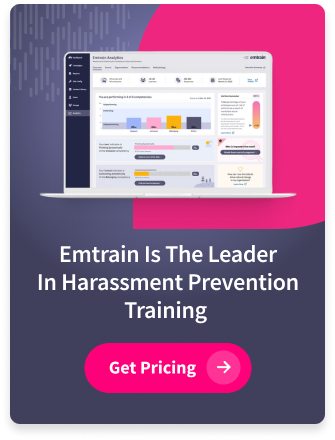As HR becomes increasingly data driven, we focus a lot on measuring: formally tracking unconscious bias training efficiency and efficacy, collecting survey data and analyzing employee responses, and benchmarking efforts versus short term objectives, annual goals, peers, etc. Over the past two years, our team at Emtrain has been building out our quantitative capabilities, recognizing that our online training has an immense amount of value in its data: employee insights, measures of group sentiment, and key indicators that form our Workplace Culture Benchmark™.
But with all the move to quantitative measurement, we haven’t forgotten the importance of the social arts: storytelling, social polling, and social gatherings. All of these have a role to play as you design your unconscious bias program.
Storytelling
Storytelling is an ancient human art. Stories inform, influence, and ingrain themselves in people’s minds. That’s why storytelling is used by innovators, marketing teams, and the most effective leaders.
Stories on screen
One of the hallmarks of Emtrain’s online training has always been the little stories we tell via video of awkward things that happen in the workplace. Someone can tell you what microaggressions are, and warn you not to commit them, but there’s nothing like watching as microaggressions happen. Even if it hasn’t happened to you, it’s easy to see how uncomfortable it is when someone reaches out to touch your natural hair, or you’re asked where you’re from because of your skin tone, or someone assumes you’re younger than you are (and you see on their face how surprised they are when they finally meet you in person!)
Collecting stories at work
Storytelling is particularly impactful when it comes from people within your own organization. There’s a range of ways to bring the stories of your people—and the unconscious bias they’ve experienced in the workplace—to inform and influence others. And it can be cathartic for some people who write, record or otherwise share their story.
Companies that employ storytelling techniques in their unconscious bias programs collect stories from employees that showcase their personal experiences: the ways in which they’ve been misunderstood or marginalized. Where they’ve noticed unconscious bias in the workplace, when they’ve been second guessed or quieted, but by someone they believed was a good person, just unaware of the impact of their words or actions.
What you do with these stories depends on the psychological safety within your organization, and how much of a part storytelling plays in your unconscious bias strategy. Stories or parts of stories might be shared without naming the author (though names could be attributed if everyone is comfortable with it.)
- Pull a synopsis from each story and use them in presentations about your diversity initiative.
- Print key quotes on large posters and hang them gallery style around the main common area for people to view.
- Publish a story series on an intranet site or other internal communication channel.
Using stories to change stubborn minds
Personal experiences can be impactful to anyone who hears them, but may be particularly useful for those who question the investment in an unconscious bias program because they don’t think there’s a problem at your company. One approach, used during an executive offsite, was to play voice recordings of employees telling their personal story of a time they were impacted by bias at work, and how it made them feel. With all key leaders in a single conference room, the lights were dimmed, the audio was turned up, and the recordings played. Most eyes were wet by the end of the session.
Empowerment through stories
At some point, employees might feel comfortable presenting their stories in small groups, in larger internal meetings, or even on stage at client or partner events. Employee Resource Groups may already be employing this technique as a way to build relationships and support one another across common experiences. Others may feature a few storytellers at internal events like monthly town halls as a way to keep unconscious bias awareness as part of the agenda on a regular cadence.
Companies like Microsoft and Cisco have featured highly successful employees sharing very personal experiences at external corporate events. These brave employees have highlighted their struggles—with homelessness, drug addiction, mental illness, hate crime victimization, rampant discrimination—in very moving and impactful ways. Be cautioned: this is not for everyone, nor should it be an early feature of a program, nor do you ever want to pressure someone who is an “other” to share their story to enlighten “the rest of us.” Most employees may never be comfortable sharing their personal stories on the public stage. But for someone with the right personality, when they are in a place of psychological safety, when they feel supported by their organization, and when they believe that sharing their own story can help others, it’s transformational.
Social polling
In the workplace, we’re always interested in what people think. Companies have been using longitudinal engagement surveys for years, and many more are starting to use short quick pulse surveys, either as a supplement or standalone to get a gauge of opinion.
To enable more transparency and buy-in, and greater collective knowledge, we’re also seeing greater use of instant polling apps. First used at conferences, they let people in the room answer a question and see the collective results usually up on the big screen. These tools, like Slido and Mentimeter are now making their way into our workshops and meetings, embedded right in our presentation slides, making them an easy way to drive meeting engagement and help people feel they’ve been heard. The polling tools allow for a variety of question types, including word cloud and open scrolling text, allowing for customized responses.
Social polling is a key part of Emtrain’s online training. We show learners video scenarios, and collect their opinion on the behaviors they’ve observed. Our scale, called The Workplace Color Spectrum™, helps the learner rate behaviors from positive (green) to toxic (red), or somewhere in the middle: yellow (demotivating) or orange (demoralizing). Learners see their own answer alongside the answers from their colleagues (anonymized, aggregated). This gives them an instant view of whether they’re in the middle of the pack or if they’re an outlier, perhaps they were more or less offended than their peers.
We also ask questions about each learner’s own opinions and behaviors—and their observations of the behaviors of their colleagues, managers, and management—using a variety of question types. Real-time, we share back what others in their organization said, as well as where they stand versus other learners from all of our client companies.
We’re very interested in how social polling can drive greater transparency and open dialogue to help address and solve tricky workplace culture issues. That’s why Emtrain also packages the insights from our courses (anonymized, aggregated) for company leadership, so they have a better understanding of what employees are observing and feeling. We also use our Workplace Culture Benchmark™ to rank companies and their peers on six key indicators of workplace culture health, along with suggested next steps.
Social gathering
There are so many reasons to gather as a community, and people particularly love to come to celebrations. Whether they’re done online, in person, over food, or enjoying a common experience of a game or a performance, they help connect colleagues and refresh relationships. Over the past years, one of the typical ways of gathering was over cultural celebrations for a diverse range of holidays, or months that recognize the importance of people’s heritage or sexual orientation or other characteristics worthy of recognition.
It’s definitely time to evolve from just serving cultural foods or handing everyone a rainbow flag sticker. How can you share the cultural or social significance of the theme you’re celebrating? What were the historical milestones? What sacrifices were made to bring us collectively to today’s appreciation?
To make a lasting impression, consider finding a way to provide more context to educate and inform and engage your colleagues. Consider combining storytelling and social gatherings. Using a platform like Storybolt, you could show a documentary that focuses on the topic at hand, and host a facilitated online discussion with the filmmaker afterwards. For example, if you’re looking to raise employee awareness of structural racism, consider showing the movie “Lost Legends”, a documentary by StoryBolt collaborator, Pawlet Brookes. It delves into the experiences of #racism, structural racism towards Black History, and the necessity to move Black Inclusion and Anti-racism #DEI efforts beyond the status quo.”
Maybe you still host a Mexican feast with traditional foods for Cinco de Mayo. But instead of letting people load up their plates at the buffet table and scurry back to their desk, have them stay and share. Imagine the impact of a colleague telling her own personal story of her grandmother and how she’d spend all day making tamales. Describing where she sourced her ingredients, how she’d push things aside to create a workspace in the kitchen, the steam and scents rising from the baskets as the tamales cooked. And perhaps, how it was the grandmother’s dream for her daughter to go to college, in the United States, so she could find success. And how the family sacrificed to put her through school so she could earn a computer science degree, and how her appreciation drives her to be the very best engineer and how she prides herself on having clean code. And how the video conferencing app she helps design and iterate lets her see her grandmother every Sunday, so even though she’s far away. Perhaps a story like this helps others see through their assumptions and stereotypes: Of Mexican immigrants. Of people who speak Spanish to each other at the lunch tables. Of junior programmer pods. Of female engineers. Of women’s ambition.
Unconscious bias has a way of embedding itself in the mind until it is slowly drawn out through awareness. By using social polling, we learn where we and others stand. By telling stories we find opportunities to grow empathy. By social gatherings, we strengthen a community with shared experience. Each of these tools has a role in your Managing Unconscious Bias program, even one that’s got a quantitative slant.
Contact us if you’d like to see some of Emtrain’s famous video scenes, or how our social polling works within our training suite (Managing Unconscious Bias, Belonging & Inclusion, Preventing Workplace Harassment, Code of Conduct, etc)








